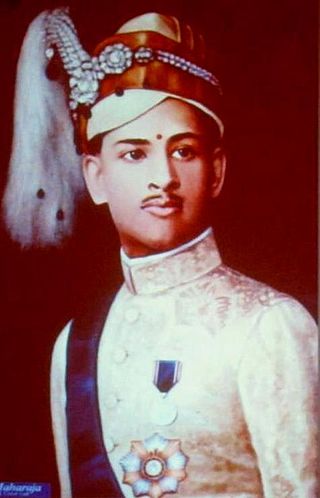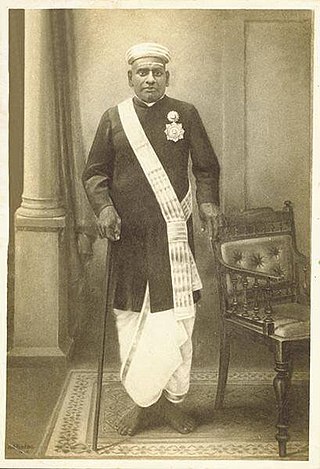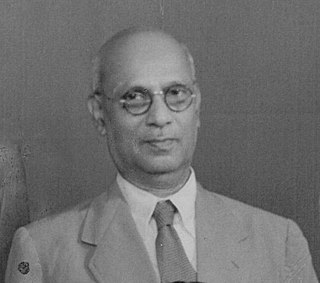Swathi Thirunal Rama Varma was the Maharaja of the Kingdom of Travancore. He is also considered as a brilliant music composer and is credited with over 400 classical compositions in both Carnatic and Hindustani style.

Sree Padmanabhadasa Sree Chithira Thirunal Balarama Varma, popularly known as Sree Chithira Thirunal, was the last ruling Maharaja of the Indian princely state of Travancore, in southern India until 1949 and later the Titular Maharajah of Travancore until 1991. His reign is known for several notable reforms that have indelible impact on the society and culture of Kerala.

Tigalari, also known as Tulu script, is a Southern Brahmic script which was used to write Tulu, Kannada, and Sanskrit languages. It was primarily used for writing Vedic texts in Sanskrit. It evolved from the Grantha script. It is called as Tigalari lipi in Kannada-speaking regions and Tulu speakers call it as Tulu lipi. It bears high similarity and relationship to its sister script Malayalam, which also evolved from the Grantha script.
Vatteluttu, popularly romanised as Vattezhuthu, was a syllabic alphabet of south India and Sri Lanka used for writing the Tamil and Malayalam languages.
The history of Thiruvananthapuram dates back to the 18th century AD. In 1795, the city became the capital of the princely state of Travancore. Several historic landmarks of the city, including the Kowdiar Palace, University of Kerala, and Napier Museum were built during that period. After independence, Thiruvananthapuram was made the capital of the state of Kerala.

Ayilyam Thirunal Rama Varma (1832–1880) was the ruler of the princely state of Travancore in India from 1860 to 1880. His reign was highly successful with Travancore gaining the appellation of "model state of India". Ayilyam Thirunal was the nephew of Uthram Thirunal and Swathi Thirunal and grandson of Gowri Lakshmi Bayi.

The city of Thiruvananthapuram has been the centre of cultural activities of Kerala (India) from the time it was made capital of Travancore in 1745. The capital city is a major intellectual and artistic center. The Thiruvananthapuram Museum and Thiruvananthapuram Zoo were started during the reign of Swathi Thirunal (1813–1847) and are one of the oldest of their kind in India. The city's libraries include the Trivandrum Public library, which was started in 1829. The Swathi Thirunal College of Music and 'College of fine arts' are the leading institutions related to music and arts.

Formerly known as the Oriental Library, the Oriental Research Institute (ORI) at Mysore, India, is a research institute which collects, exhibits, edits, and publishes rare manuscripts written in various scripts like Devanagari (Sanskrit), Brahmic (Kannada), (Nandinagari) (Sanskrit), Grantha, Malayalam, Tigalari, etc.

State Central Library of Kerala is also known as Trivandrum Public Library. It is in the center of Thiruvananthapuram city, the capital of Kerala. PH 7736893884

Visakham Thirunal Rama VarmaFRAS was the Maharaja of the erstwhile Indian kingdom of Travancore from 1880 to 1885 AD. He succeeded his elder brother Maharajah Ayilyam Thirunal to the throne of Travancore.

The Travancore royal family was the ruling house of the Kingdom of Travancore. They had to give up their ruling rights in 1949 when Travancore merged with India and their political pension privileges were abolished in 1971. The family is descended from the Ay/Venad family and the Chera dynasty.

Mahamahopadhyaya T. Gaṇapati Śāstrī (1860–1926) was a Sanskrit scholar who was editor of the Trivandrum Sanskrit Series, and discovered the plays of Bhasa. He was also the principal of the Sanskrit college for some time, around 1903. His father name is Ramasubba Iyer. He was born at Taruvai in Tirunelveli District in 1860 A.D

Krishna Venkateswara Sarma (1919–2005) was an Indian historian of science, particularly the astronomy and mathematics of the Kerala school. He was responsible for bringing to light several of the achievements of the Kerala school. He was editor of the Vishveshvaranand Indological Research Series, and published the critical edition of several source works in Sanskrit, including the Aryabhatiya of Aryabhata. He was recognised as "the greatest authority on Kerala's astronomical tradition".
Rudrapatna Shamasastry FRAS (1868–1944) was a Sanskrit scholar and librarian at the Oriental Research Institute Mysore. He re-discovered and published the Arthashastra, an ancient Indian treatise on statecraft, economic policy, and military strategy.

Swathi Thirunal College of Music is a music college in Thiruvananthapuram, Kerala, India. It was founded in 1939. It was first named as "The Music Academy". The name was renamed as Swathi Thirunal College of Music in 1962. The founder of this institution was the last reigning King of Travancore, Sree Chithira Thirunal Balarama Varma in 1939. The administration of the institution was under the control of the Travancore Royal Family earlier. Eminent musicians like Muthiah Bhagavathar who was the first Principal, Semmangudi Srinivasa Iyer, etc. have served as Principals of this college.

Nandināgarī is a Brahmic script derived from the Nāgarī script which appeared in the 7th century AD. This script and its variants were used in the central Deccan region and south India, and an abundance of Sanskrit manuscripts in Nandināgarī have been discovered but remain untransliterated. Some of the discovered manuscripts of Madhvacharya of the Dvaita Vedanta school of Hinduism are in Nandināgarī script.
Thirunal is a surname. Notable people with the surname include:

Moolam Thirunal Sethu Parvathi Bayi (1896–1983), better known as Amma Maharani, was the Junior Maharani (Queen) of Travancore as well as a promoter of Indian Classical music. She was the mother of Chithira Thirunal Balarama Varma, the last King of Travancore. She was the president of the National Council of Women in India in 1938–1944.

Dr. L. A. Ravi Varma, was a historian, ophthalmologist and philosopher of the 20th century in Kerala, India. He was a critical figure who enriched the Ayurvedic literature contributing to its renaissance. In January 1940, he was appointed as Director of the joint Oriental Manuscripts Libraries of the Government of Kerala and the Kerala University. He was conferred the Honorary Title of Vaidyashastra Nipunan and Gaveshana Thillakan by Chithira Thirunal Maharaja, the King of Travancore, Kerala, India.














